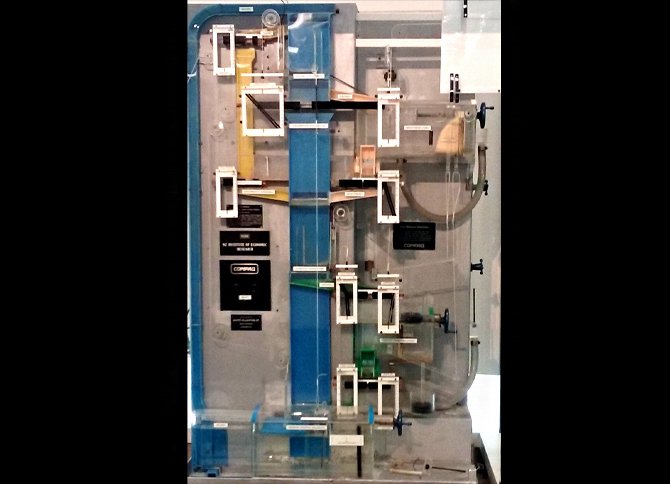The MONIAC is a notable example of an analogue computer. It is an economic simulator that used water to model the flows of money in a macro-economy. The MONIAC was developed by New Zealand economist Bill Phillips.

MONIAC, April 2017. Photo courtesy of R M Sharp.
The MONIAC belongs to a long line of analogue devices that have influenced human history. The oldest known (150-100 BC) are the Antikythera orrery and Hipparchus’ astrolabe. More recent (1600 to 1900s) examples of importance to engineers and scientists are the sector, planimeter, slide rule and differential analyser. Notable 20th century devices include gun and bomb aiming computers, network analysers and the water-based MONIAC.
An analogue computer uses the continuously changeable aspects of physical phenomena such as electrical, mechanical, or hydraulic quantities to model the problem being solved.
Bill Phillips
Alban William Housego Phillips (1914-1975) was one of New Zealand’s most accomplished economists of the twentieth century. Born in New Zealand and brought up on a dairy farm, he moved to Australia soon after leaving school and in 1937 went to China. He escaped ahead of the Japanese invasion that year, reached Britain via the Trans-Siberian Railway, and studied electrical engineering.
When the Second World War broke out Phillips joined the Royal Air Force and was posted to Singapore, later escaping to Java on a troopship as the island fell to Japanese forces. Here he was captured by the Japanese and made a POW. He quickly put his inventive skills to use in the camp, building a miniature radio hidden in a clog and creating an immersion element, run from the camp lighting, to boil water for hot drinks.
Phillips received an MBE for his wartime efforts. Awarded a New Zealand Forces scholarship, he attended the London School of Economics from 1946, studying first sociology and then economics. It was here that he developed a machine for demonstrating and calculating the workings of the macro-economy – the broad relationships between elements of the economy. Dubbed MONIAC, this has some claim to be the world’s first macro-economic computer.
Phillips’ most famous contribution to economic understanding remains the Phillips Curve, a relationship between unemployment and inflation that Phillips analysed during the 1950s. He published his conclusions in 1958, which were applied by Paul Samuelson and Robert Solow to the United States and became a significant cornerstone of economic analysis and thinking for the next thirty or more years.
In 1967 Phillips moved to Australia and took up a position in the Australian National University. However he suffered a stroke two years later and retired to New Zealand, where he taught at the University of Auckland. He died in March 1975.
Development of the MONIAC
Bill Phillips built his prototype machine for around £400, including parts scavenged from a Lancaster bomber. The acronym MONIAC – ‘Monetary National Income Analogue Computer’ – was reputedly invented to echo the ENIAC digital computer then being developed in the United States. By contrast with those machines, the MONIAC operated wholly on analogue principles. Around 14 were built.
One of a generation of twentieth century mechanical computing machines – others include the Differential Analyser and the Dreyer Fire Control table – MONIAC has some claim to being the world’s first econometric computer. It could carry out calculations unable to be performed by any other computer at the time, and while other machines of its era used cogs, gears and sometimes Meccano parts, the MONIAC used water to model the flows of money in a macro-economy with flows controlled by a series of floats, counterweights and valves. Linkages modelled Keynesian and classical economic principles, with various tanks representing households, business, government, exporting and importing sectors of the economy. Flows in the system represented income, spending and GDP. To their surprise, Phillips and his associate Walter Newlyn found that MONIAC could be calibrated to an accuracy of ±2%. The system was programmable, and experiments with fiscal policy, monetary policy and exchange rates could be carried out.
The first production example of the MONIAC, originally calibrated for the British economy, is on display in the Reserve Bank Museum on The Terrace, Wellington. It is the only MONIAC known to be in working order in the southern hemisphere. It was donated to the New Zealand Institute of Economic Research by the London School of Economics in 1987 and restored to working order in 1991. It was refurbished again in 2003 before being displayed as part of a New Zealand display at the 50th Venice Bienniale of Contemporary Art, a significant international exhibition. The institute loaned the MONIAC to the Reserve Bank Museum in 2006, and it underwent further restoration before being put on display in mid-2007.
Information supplied by the Reserve Bank of New Zealand Museum.
More information
Access
Access to the public is during the opening hours of the Reserve Bank Museum.
References
‘The Real MONIAC,’ Reserve Bank Museum, accessed 12 April 2017,
Location
Reserve Bank Museum, Reserve Bank of New Zealand, 2 The Terrace, Wellington.

